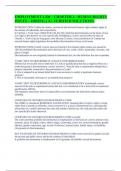EMPLOYMENT LAW - CHAPTER 2 - HUMAN RIGHTS
ISSUES – HIRING || A+ VERIFIED SOLUTIONS.
INTRODUCTION: Unlike the charter, provincial and territorial human rights statutes apply to
the actions of individuals and corporations.
In Christie v. York Corp, [1940] SCR 139, the SCC held that discrimination on the basis of race
was legal in the absence of a law specifically forbidding it. correct answers But the days of
Christie v. York Corp are long gone; over the past 55 years, every jurisdiction in Canada has
enacted human rights legislation that prohibits discrimination in key social areas.
INTRODUCTION (cont'd): correct answers Ontario's first human rights statute was passed in
1962 & prohibited discrimination and n the basis of race, creed, colour, nationality, ancestry, and
place of origin.
Discrimination on was originally limited to intentional acts, but the definition has now expanded.
3 PART TEST TO DETERMINE IF A RULE IS DISCRIMINATORY:
Meiorin has set out this test to determine if a rule or qualification that has a negative effect on a
protected group is discriminatory: correct answers 1. Was the rule or requirement adopted for a
purpose rationally connected to the performance of s job?
2. Was it adopted in an honest belief that it was necessary to satisfy a legitimate business
purpose?
3. Was it reasonably necessary to accomplish that purpose?
3 PART TEST TO DETERMINE IF A RULE IS DISCRIMINATORY (continued): correct
answers If the rule or requirement meets this test, it is considered to be a bona Fide occupational
qualification, BFOQ,
The employer must show that it is impossible to accommodate the individual without undue
hardship.
OVERVIEW OF ONTARIO'S HUMAN RIGHTS CODE:
The OHRC is considered REMEDIAL LEGISLATION, meaning that it exists to right a wrong
rather than to punish an offender, correct answers It is a quasi-constitutional law, meaning that
when there is a conflict between the code and another Ontario law, the code prevails unless the
law specifically states otherwise.
OVERVIEW OF ONTARIO'S HUMAN RIGHTS CODE: (cont'd):
The code currently prohibits discrimination in employment on the basis of: correct answers race,
ancestry, place of origin, colour, ethnic origin, citizenship, creed, sex, sexual orientation, gender
identity, gender expression, age, record of offences, marital status, family status, or disability.
(16 grounds of discrimination).
KEY FEATURES OF ONTARIO'S HUMAN RIGHTS CODE correct answers It applies to both
the private and public sector and to the conduct of individuals,
It prohibits discrimination in employment on 16 grounds, & prohibits sexual harassment,
, KEY FEATURES OF ONTARIO'S HUMAN RIGHTS CODE (continued): correct answers
Intent to discriminate is not necessary, & the effect of an employers actions or rules will mater as
much as intent,
Employer has a duty to accommodate unless undue hardship,
It's not possible to contract outside the code,
Code applies to every stage of employment relationship, incl. recruit.
ONTARIO'S HRC:
The code provides that everyone has the right to be free of discrimination in five 5 areas of social
activity:
- Services, goods, and facilities,
- Accommodation/housing, correct answers - Contracts,
- Employment,
- Membership in vocational associations & trade unions.
Over 75 percent of human rights complaints arise in the workplace.
AREAS COVERED: BY OHRC:
The code provides that everyone has the right to be free of discrimination in five 5 areas of social
activity: correct answers Services my goods, and facilities,
Accommodation, housing,
Contracts,
Employment,
Membership in vocational association. And trade unions,
PROHIBITED GROUNDS OF DISCRIMINATION IN EMPLOYMENT:
Race, is not defined in the Code But is closely related to colour and ethnic origin;
Ancestry refers to family descent and is closely related to place of origin, meaning a person's
country or region of birth. correct answers Ethnic origin refers mainly to culture, and it is not
limited to recent immigrants, it can apply to third or fourth generation Canadians;
Citizenship status includes status as a landed immigrant, refugee, or non-permanent resident.
PROHIBITED GROUNDS OF DISCRIMINATION IN EMPLOYMENT: correct answers
Creed, refers to a person's religion or faiths and the courts have left open the possibility that it
could refer to system of political opinion,
Sex, refers to discrimination based on sex/gender: male or female, including pregnancy &
breastfeeding in public areas.
PROHIBITED GROUNDS OF DISCRIMINATION IN EMPLOYMENT:
(Continued): correct answers Sexual orientation, refers to a person sexuality, e.g. Lesbian, gay,
bisexual, heterosexual.
Gender identity, refers to a person's intrinsic sense of self, especially their sense of self as male
or female.
THE CODE PROHIBITS:




